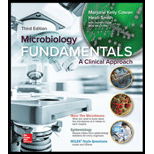
Microbiology Fundamentals: A Clinical Approach
3rd Edition
ISBN: 9781259709227
Author: Marjorie Kelly Cowan Professor, Heidi Smith
Publisher: McGraw-Hill Education
expand_more
expand_more
format_list_bulleted
Concept explainers
Question
Chapter 12, Problem 1VC
Summary Introduction
To determine:
The relationship of specific events of inflammation to the symptoms of pneumonia in the given picture.
Introduction:
Pneumonia is an infection that causes inflammation in the air sac in both the lungs and it might fill with fluid. It includes symptoms such as cough, fever, difficulty in breathing and chills.
Expert Solution & Answer
Want to see the full answer?
Check out a sample textbook solution
Students have asked these similar questions
help tutor please
Q8. A researcher wants to study the effectiveness of a pill intended to reduce stomach heartburn in pregnant
women. The researcher chooses randomly 400 women to participate in this experiment for 9 months of their
pregnancy period. They all need to have the same diet. The researcher designs two groups of 200 participants:
One group take the real medication intended to reduce heartburn, while the other group take placebo
medication. In this study what are:
Independent variable:
Dependent variable:
Control variable:
Experimental group: "
Control group:
If the participants do not know who is consuming the real pills and who is consuming the sugar pills.
This study is
It happens that 40% of the participants do not find the treatment helpful and drop out after 6 months.
The researcher throws out the data from subjects that drop out. What type of bias is there in this study?
If the company who makes the medication funds this research, what type of bias might exist in this
research work?
How do I determine the inhertiance pattern from the pedigree diagram?
Chapter 12 Solutions
Microbiology Fundamentals: A Clinical Approach
Ch. 12.1 - Summarize the three lines of host defenses.Ch. 12.1 - Define marker and discuss its importance in the...Ch. 12.1 - Prob. 3AYPCh. 12.1 - Prob. 4AYPCh. 12.1 - Name three kinds of blood cells that function in...Ch. 12.1 - Connect the mononuclear phagocyte system to innate...Ch. 12.1 - Describe how T and B lymphocytes are involved in...Ch. 12.1 - Prob. 8AYPCh. 12.1 - Prob. 1MMCh. 12.1 - Prob. 1NP
Ch. 12.1 - Prob. 2MMCh. 12.2 - Prob. 9AYPCh. 12.2 - Prob. 10AYPCh. 12.2 - Prob. 11AYPCh. 12.2 - Prob. 2NPCh. 12.3 - List the four major categories of nonspecific...Ch. 12.3 - Prob. 13AYPCh. 12.3 - Prob. 14AYPCh. 12.3 - Prob. 15AYPCh. 12.3 - Name four types of antimicrobial host-derived...Ch. 12.3 - Prob. 17AYPCh. 12.3 - Prob. 3NPCh. 12.3 - NCLEX PREX 4. A patient presents to the emergency...Ch. 12.3 - Prob. 5NPCh. 12 - A microorganism carries _____ markers and a B cell...Ch. 12 - Prob. 2QCh. 12 - The pediatrician you work for has just recommended...Ch. 12 - Prob. 4QCh. 12 - In what way is a phagocyte a tiny container of...Ch. 12 - Prob. 6QCh. 12 - Prob. 7QCh. 12 - Prob. 8QCh. 12 - Explain the physiological events that lead to each...Ch. 12 - Prob. 10QCh. 12 - Prob. 11QCh. 12 - Prob. 12QCh. 12 - Prob. 13QCh. 12 - Why do you think that the intestines have one of...Ch. 12 - Prob. 15QCh. 12 - Prob. 16QCh. 12 - Prob. 17QCh. 12 - Prob. 18QCh. 12 - Figure 12.3 demonstrates that lymphatic fluid...Ch. 12 - Prob. 20QCh. 12 - Prob. 21QCh. 12 - Prob. 1VC
Knowledge Booster
Learn more about
Need a deep-dive on the concept behind this application? Look no further. Learn more about this topic, biology and related others by exploring similar questions and additional content below.Similar questions
- 22. Which of the following mutant proteins is expected to have a dominant negative effect when over- expressed in normal cells? a. mutant PI3-kinase that lacks the SH2 domain but retains the kinase function b. mutant Grb2 protein that cannot bind to RTK c. mutant RTK that lacks the extracellular domain d. mutant PDK that has the PH domain but lost the kinase function e. all of the abovearrow_forwardWhat is the label ?arrow_forwardCan you described the image? Can you explain the question as well their answer and how to get to an answer to an problem like this?arrow_forward
- Describe the principle of homeostasis.arrow_forwardExplain how the hormones of the glands listed below travel around the body to target organs and tissues : Pituitary gland Hypothalamus Thyroid Parathyroid Adrenal Pineal Pancreas(islets of langerhans) Gonads (testes and ovaries) Placentaarrow_forwardWhat are the functions of the hormones produced in the glands listed below: Pituitary gland Hypothalamus Thyroid Parathyroid Adrenal Pineal Pancreas(islets of langerhans) Gonads (testes and ovaries) Placentaarrow_forward
arrow_back_ios
SEE MORE QUESTIONS
arrow_forward_ios
Recommended textbooks for you
 Human Heredity: Principles and Issues (MindTap Co...BiologyISBN:9781305251052Author:Michael CummingsPublisher:Cengage Learning
Human Heredity: Principles and Issues (MindTap Co...BiologyISBN:9781305251052Author:Michael CummingsPublisher:Cengage Learning Human Biology (MindTap Course List)BiologyISBN:9781305112100Author:Cecie Starr, Beverly McMillanPublisher:Cengage Learning
Human Biology (MindTap Course List)BiologyISBN:9781305112100Author:Cecie Starr, Beverly McMillanPublisher:Cengage Learning Human Physiology: From Cells to Systems (MindTap ...BiologyISBN:9781285866932Author:Lauralee SherwoodPublisher:Cengage Learning
Human Physiology: From Cells to Systems (MindTap ...BiologyISBN:9781285866932Author:Lauralee SherwoodPublisher:Cengage Learning



Human Heredity: Principles and Issues (MindTap Co...
Biology
ISBN:9781305251052
Author:Michael Cummings
Publisher:Cengage Learning

Human Biology (MindTap Course List)
Biology
ISBN:9781305112100
Author:Cecie Starr, Beverly McMillan
Publisher:Cengage Learning

Human Physiology: From Cells to Systems (MindTap ...
Biology
ISBN:9781285866932
Author:Lauralee Sherwood
Publisher:Cengage Learning
